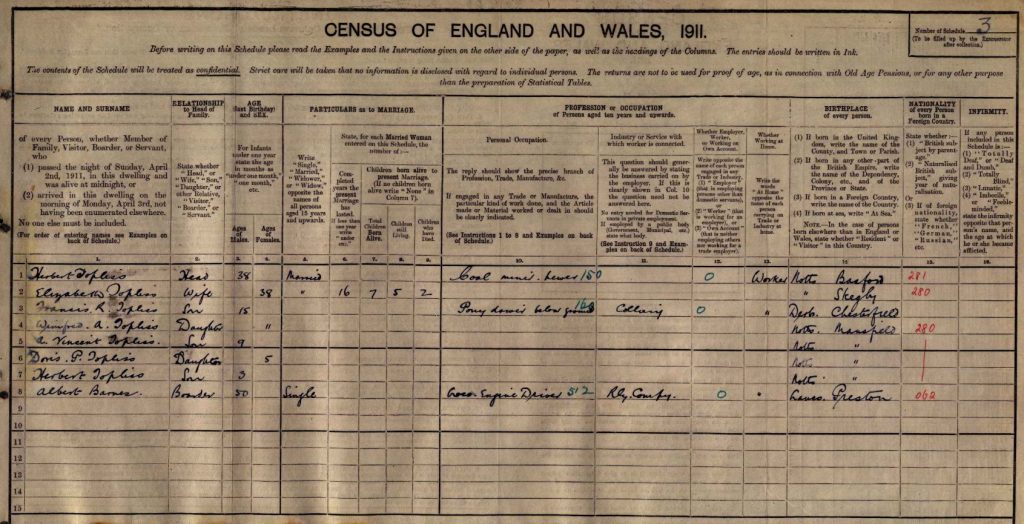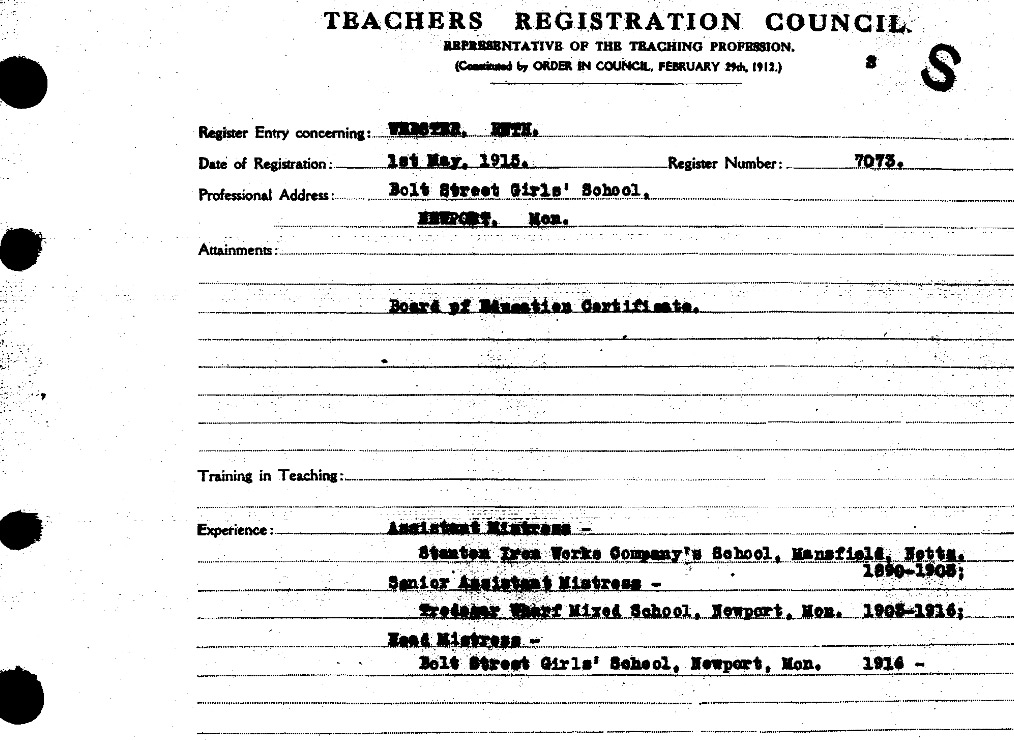If you remember the BBC serial drama, The Monocled Mutineer you’ll doubtless remember Percy’s beleaguered guardians, the Websters. Annie was always being pestered for money, and Frank was always being pestered for his bike. But this is a look at the real Webster family. And it’s not what you’d expect. The tale might even provide some clarity on Percy’s revolutionary roots.
It’s difficult to know where to start with the Websters, as much of what people think they know about them has arisen of sometimes inaccurate, or at the very least, ‘factually elusive’, myths and fictions made famous by Bleasdale’s 1986 drama, The Monocled Mutineer. Whilst the 1978 book on which the drama is based gets it right on many occasions, the depiction of Annie Webster, Percy’s aunt, living in a ‘one-up, one-down terrace in the shadow of Blackwell pit’ has roots based in some crude, romantic stereotype of pit families at this time. Sadly, you’ll have to revise your expectations of Annie’s long-suffering and famously bronchitic husband Frank too, as Annie’s husband was Ernest Nixon and neither of the couple appears to have to have lived in Blackwell since their marriage in 1910. Ernie’s signature consumptive state didn’t lead to an early grave either as both Ernie and his legendary missing bicycle (should it have ever really existed at all) were still alive and kicking in the 1939 census.
In fact you may be surprised to learn that the real Webster family were well-educated, devout, hard-working and aspirational, eventually living out their final days in a smart townhouse in West Kensington, London
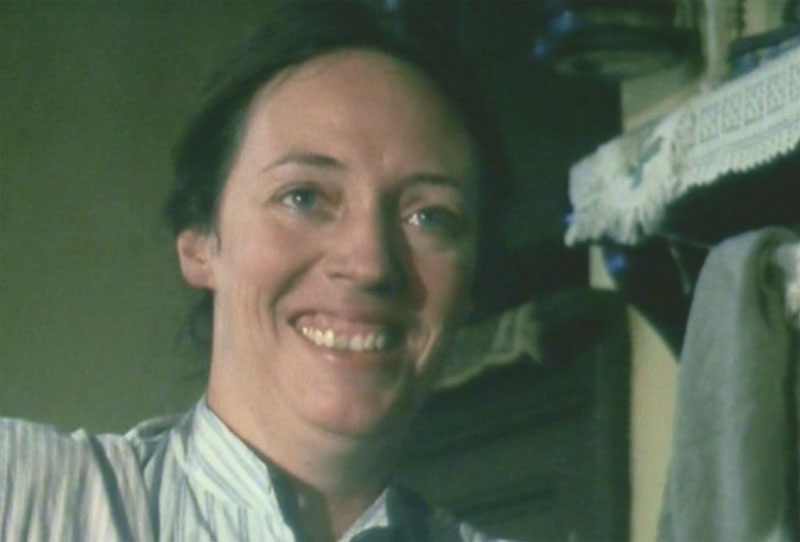
Born in Taversal, near Sutton-in-Ashfield in 1882, Ernest Nixon was the son of coal miner John Nixon and his wife Mary, of Whittington in Chesterfield. The family appear to have moved to Medan Bank in Skegby sometime in the 1880s. Whilst it’s entirely likely that Ernest was a coal miner when they met (he certainly was in the 1901 census) Annie, like her sister Ruth, was employed locally as school teacher. In the 1901 census Percy can be seen living next door to the Primitive Methodist Chapel on Skegby Lane with his grandmother Alice Webster (b.1864), his aunt Ruth (b.1876), his aunt Annie (b.1882) and his uncle John, a colliery clerk. Both aunts are listed as teachers. Percy’s grandfather William Webster suffered ill-health and committed suicide. The 53-year old had been treated for health issues and depression for some three years, and as a consequence had been forced to endure long spells of unemployment. At his wits’ end he had walked out in front of a train at a level-crossing near the Midland Station at Taversal (Shocking Suicide at the Railway in Taversal, Long Eaton Advertiser – 07th September 1900).
Their lodgings on the premises (or at the very least adjacent to the premises) of the Primitive Methodist Chapel on Skegby Lane is an interesting one; not just because it had a schoolroom (where Annie may have taught) but because in the opinion of The Mansfield Reporter, the church, which was firmly rooted in the nonconformity movement of various religious ‘dissenters’, had a long-standing affiliation with ‘Saints and Socialists, Ranters and Radicals, Schismatics and Separatists’. The feeling among Conservatives in the area was that its ‘politics are more of their religion than the gospel’ (Mansfield Reporter 14 September 1888, p.5) . The Nonconformist Liberal MP, John Carvell Williams used to speak here. Carvell Williams also had strong links to the Liberal Association and the fiercely nonconformist Liberation Societies of Newport, Merthyr Tydfil, Aberdare and Llanelly, which we’ll come back to shortly.
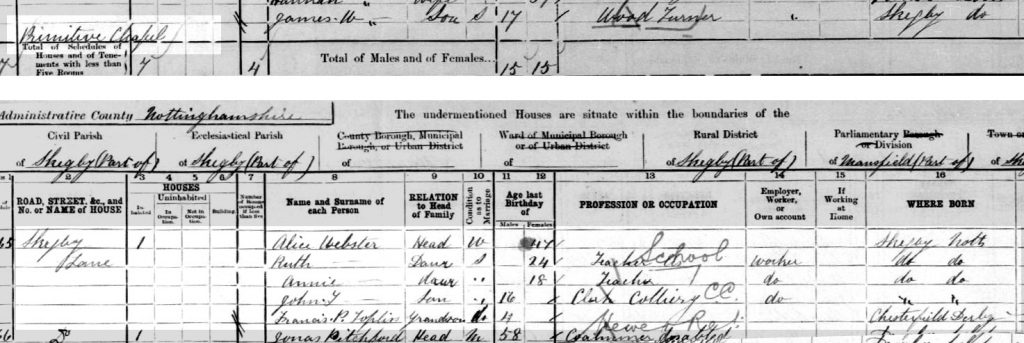
From what we can ascertain, Percy spent much of childhood and youth with the Websters, and Ruth Webster in particular, joining her at intervals in Newport in South Wales when she landed a job as Senior Assistant Mistress at Tredgegar Wharf Mixed School in 1905. However, both Annie and her grandmother were still very closely involved in Percy’s upbringing as both names feature in a report in the Derbyshire Courtier dated 25th July 1908. It seems the 11 year old Percy had been charged with stealing three-dozen evening newspapers valued at 1s 6d from a newsagent in Shirebrook. Toplis had apparently mentioned that he knew a man at the newspaper’s offices and the newsagent, somewhat reluctantly by all accounts, had given the lad the job of selling all 36 newspapers. At the time of the offence Percy had been living with his Uncle Samuel Topliss in Sherwood Street, Mansfield Wodehouse. When pressed about his parents, Percy claimed that he rarely saw them. At the time of the court hearing, Toplis was back with his grandmother at Stanton Hill. His grandfather Samuel Topliss admitted the boy was out of control, and a short-time later Annie Webster arrived to claim him (Thief at 11 Years, Derbyshire Courier 25 July 1908, p.7).
At this time Percy was have attending (fairly irregularly one might imagine) Stanton Ironworks Company’s School. Bill Allison and John Fairley have this down as South Normanton School in the book, but the headmaster they mention in regard to some laudanum prank that Percy’s pulls on his school mates only ever served as head of Stanton Hill Ironworks School (John Bailey). Stanton Ironworks Company’ s School is also the school that his aunt Ruth Webster taught at. Ruth was Assistant Mistress here from 1890 to 1905 when she left for Newport. 1
Toplis: There speaks the king of the Miners Federation. The very man who starts every sentence with … [mimics] … ‘bugger the bosses’.
Frank: Aye. Well I work hard so I’m entitled. You do sweet F.A.
The Monocled Mutineer – Alan Bleasdale
The town in Monmouth South Wales couldn’t have provided a better retreat for the rebellious young Toplis. Back in 1839 Newport had seen the last large-scale armed rebellion on British soil, led by a passionate band of Chartists, Baptists and Methodists (one of the leaders was John Rees aka. Jack the Fifer whose extraordinary biography also sees him at the ‘Battle of the Alamo’: see Newport Rising)
Interestingly enough, a Welsh newspaper columnist writing articles (not generally in favour) of the Methodist and Labour movement in the South Wales Daily News went by the moniker ‘Toplis’. It was a rare name in these parts, and given its relative scarcity, I’d venture a guess that the man behind the pen name may have been Charles William Mansel Lewis of Stradey Castle: painter, conservative, colliery owner and justice of the peace in Llanelli. His gamekeeper was a Derbyshire man called Toplis and his man had acquired a fearsome reputation as an uncompromising ‘giant killer’ after a deadly encounter with poaching-Goliath, Arthur Nurse (Llanelly Poaching Affray, South Wales Daily News, 19th December 1889, p.3). According to the Western Mail, Nurse had led the riot on the Llannelly Conservative Club just a few years before (Terrible Affair at Llanelly, Western Mail 13 November 1889, p.3)
Timeline
1890 – Percy’s maternal aunt Ruth Webster is recruited as Assistant Mistress at Stanton Ironworks Company’s School
August 22nd 1896 – Francis Percy Toplis is born to Rejoice Elizabeth Webster (b.1874) and Herbert Topliss (b.1874) on Sanforth Street in Whittington, Chesterfield. At this time the street was also home to future Communist revolutionary, Rose Ellis Smith (b.1891) who subsequently moved to Mansfield. Smith later recalled that most of the Sanforth residents consisted of miners’ families, but there was also a sprinkling of shop assistants, clerks and pottery workers. Many of the families that lived in the bottom half of Sanforth Street were of Irish descent (The Times and Life of Rose Smith in Britain and China, 1891-1985, Gisela Chan Man Fong).
By 1927 Rose was a leading figure in the National Minority Movement and a key ally of South Wales Mining legend, A.J Cook of the Miners Federation. Cook had been Churchill’s nemesis in the Welsh Valley for the best part of 15 years. According to the autobiography of British spy, John Baker White, Cook and Rose were under close surveillance in Mansfield in 1927 (True Blue, John Baker White, Frederick Muller, 1970). In April 1918, Cook was charged under the Defence of the Realm Act for sedition alongside several other Rhondda Socialists. The action took place in Pontypridd, where the Smith family had lived immediately prior to moving to Chesterfield (Socialist Speeches, Western Mail 18 April 1918, p.4). Cook had been advocating revolution. He was sentenced to three months imprisonment.

25th September 1896 – Percy Topliss is baptised at St Andrews’ Church in Skegby. The family are still living on Sanforth Road in Chesterfield.
September 5th 1900 – William Webster, the husband of Alice Webster and Percy’s grandfather commits suicide at a level-crossing in Taversall.
April 1901 – Toplis is living with his grandmother Alice Webster, his aunts, Ruth and Annie and his uncle, John Webster at (or adjacent to) the Primitive Methodist Chapel on Skegby Lane (which also appears to have served as a school house).
April 1901 – Percy’s parents Herbert and Rejoice Topliss are living on Woodhouse Road in Mansfield Woodhouse with Percy’s sister Winifred (b.1900)
1905 – Aunt Ruth Webster lands the job of Senior Assistant Mistress at Tredegar Wharf Mixed School in Newport in Monmouthshire, South Wales (Beyond Control at Eleven, Nottingham Evening Post 05 March 1908).
21st May 1907 – Etaples Mutineer, Jesse Robert Short of Cap Coch near Mountain Ash in South Wales, enlists for the second time with 3rd Wiltshire Regiment. By October 1907 he has been discharged for theft. He uses the same name and place of birth each time: Aberdare in Monmouthshire (he was actually born In Nantyglo near Blaina). Cap Coch (meaning ‘Red Cap’) had quite a revolutionary history. The village took its name from a local smuggler who fought alongside the French Revolutionaries (see: ‘Phrygian Cap‘).
5th March 1908 – Percy Topliss, aged 11, of Mansfield, is charged with obtaining two suits clothes to the value of 24 shillings, under false pretences, from Albert Levitt, of Low Street, Sutton-in-Ashfield. Six strokes of the birch rod are awarded (Mansfield Boy, Bad Beginnings, Nottingham Evening Post, 05 March 1908, p.5).
21 July 1908 – Percy appears for the second time at Chesterfield County Police Court. He is accused of stealing three dozen evening newspapers valued at 1s 6d on June 29th. Annie Webster comes to claim the boy and promises to ensure his good behaviour (Derbyshire Courier, 21 July 1908, p.3).
1909 – On his release from prison, future Etaples muitneer Jesse Short goes to live with Edward Jones and his family at 2 Miles Row in Brynmawr in Monmouthshire, South Wales (a few miles from Blaina). The family are Baptists.
March 1910 – Major strikes break out among miners in Newport. In a letter to Home Secretary Winston Churchill, President of the Board of Trade warns that to settle the dispute between mine owners and miners it may be necessary to alter the Eight Hours Act. Believes the dispute between mine owners and miners may develop into a “very serious and far-reaching strike”. Baptist lay-preacher, James Winstone, leader of the South Wales Miners Federation – also from Newport – played a key role in these strikes and riots. He subsequently became a founding committee member of the Hands Off Russia campaign of 1919. His chief ally was J.H Thomas, whose wife Agnes had attended Bolt Street Girls School where Percy’s aunt Ruth became head in 1916.
more reading: CHAR 12/6 Official: Home Office: Newport Strike: South Wales Riots. Correspondence and papers
1910 – Sanforth Street Marxist, Rose Ellis Smith joins Chesterfield’s Social Democratic Federation and finds employment as an elementary school teacher. Immediately prior to moving to Chesterfield, Rose and her Chartist father, Samuel Ellis were living in Pontypridd and Nantgarw in South Wales. Her mother was Sarah Ann Ellis nee Gardiner 2
September 1911 – The Rhondda Riots. Riots break out among striking miners in the Rhondda Valley of South Wales. Churchill is pressured into authorizing the use of military force 3. In November a squadron of the 18th Hussars is ordered to Pontypridd to control rioting. Alfred Gardiner, the editor of The Daily News circulated rumours that Churchill had authorized soldiers to use ammunition. The tactics were deemed disproportionately harsh and Churchill was vilified in South Wales for years.
November 1910 – Auntie Annie Webster marries Ernest Nixon in Skegby, Mansfield. As neither Annie or Ernest appears again in the English census and electoral rolls until 1939, its possible they had accompanied their cousin Edwin Shooter Jnr (b.1888) to America (Ernest and Edwin were both colliery labourers). Edwin was the son of Annie Topliss, sister of Percy’s father Herbert. Annie had married Edwin Shooter Snr, a Colliery Deputy at Blackwell Pit. Their daughter, Lily Ann Ann Shooter (Percy’s cousin) married surgeon John Alexander Percival Perera (b 1892) in Sheffield (Sheffield Daily Telegraph 19 June 1922). In 1948 the couple travel to the US on the same ship as Iris Decima Armstrong, daughter of opium & banking magnate, James Grant Forbes II. Edwin Jnr emigrated to Missouri in 1910/1911. In 1927 he can be seen as part of a delegation representing striking miners in Denver, Colorado (Las Vegas Daily Optic 27 October 1927, page 6). Edwin Snr spent the last years of his life on Church Lane in Skegness (Skegness Standard, 21 December 1932, p.4).
January 1911 – Tom Mann of the Social Democratic Federation republishes ‘Don’t Shoot‘ in The Syndicalist journal. Its publication is clearly timed to coincide with nationwide action being planned by Railway Workers and Miners. The article asks troops to refrain from firing on demonstrators in the event of military force. Mann is subsequently jailed for incitement to mutiny. In the mid-1920s Mann becomes chairman of the National Minority Movement and works closely with Sanforth Street’s Rose (Ellis) Smith.
1911 – Jesse Short joins his aunt, Mary Ann Jones (née Bufton) in Felling, Durham. His mother’s family are from Merthyr Tydfil.
1911 – The Workers Educational Association (WEA) offer Rose (Ellis) Smith a place on their WEA summer schools at Balliol College in Oxford.
April 1911 – Percy’s aunt Ruth Webster is now boarding at 72 Capel Crescent in Newport, Monmouthshire, the home of William Stokes and his family. Stokes’ daughter Clarice was an accomplished pianist. Did she give Percy any lessons? The family are Wesleyan Methodists and active members of the Newport community.
August 22nd 1911 – The Battle of Chesterfield. The National Railway Strike of 1911 sees troops brought in at Chesterfield. Fixed bayonets are used on protesters. The Social Democratic Federation deny any involvement (Battle of Chesterfield, Derbyshire Courier 26 August 1911, p.3). In Llanelli, South Wales encounter between rioters and military leave six people dead.
more reading:
https://api.parliament.uk/historic-hansard/commons/1911/aug/22/employment-of-military
February 26th 1912 – The first day of Britain’s first-ever National Coal Strike breaks out prematurely at the Blackwell and Stanton Hill pits in Mansfield (see: Coal Strike Begins, 2,000 men out at Alfreton, Sheffield Daily Telegraph, February 27th 1912/Over 10,000 Men Out in Derbyshire, Manchester Guardian, February 27th 1912
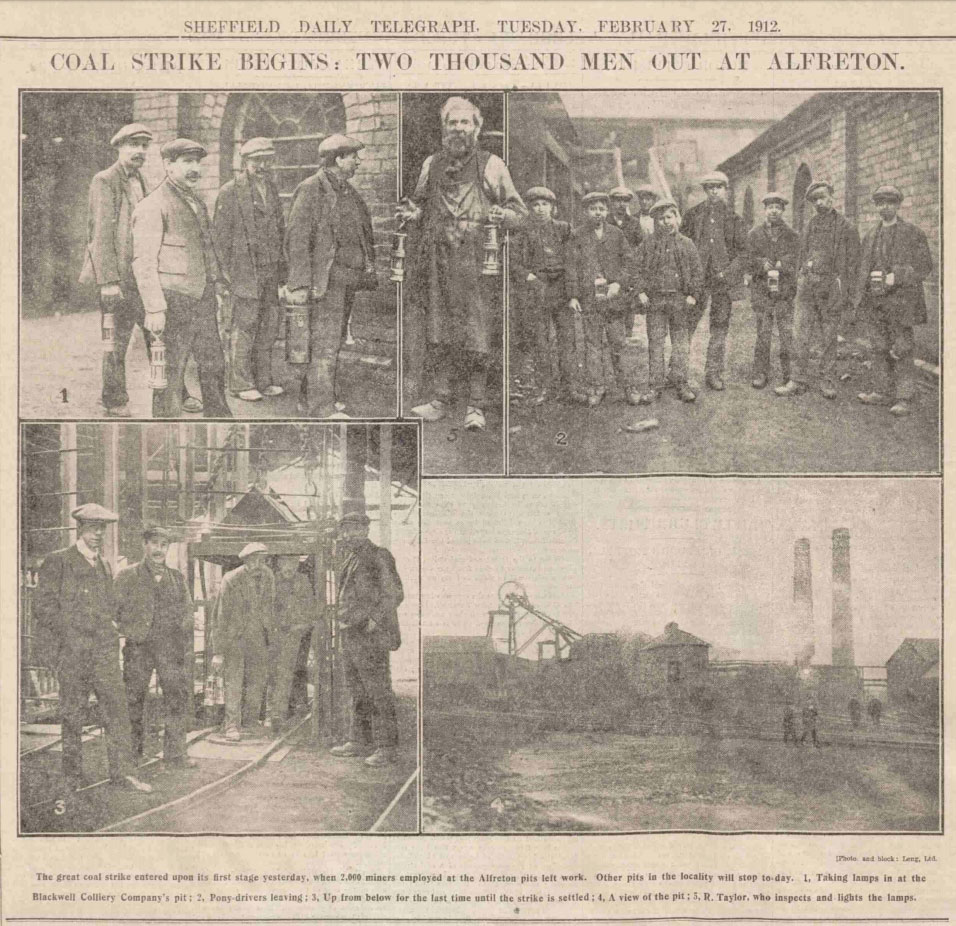
1st May 1915 – Ruth Webster is formally enrolled with the Teachers Registration Council (registration no. 7073)
9th October 1915 – Methodist Mary Toplis of Old Castle Road in Llanelly is charged with harbouring Russian emigre, Soloman Kramsky, who had entered the country illegally. Local activist Arthur Nurse and several others are also charged including Soloman’s son, Jack Kramsky. The Kramsky family had been previously been living in Mountain Ash, home of Etaples Mutineer Jesse Short (The Aberdare Leader, 28th November 1908, p.4). The father of Mary Toplis was Thomas Toplis, born 1842 in Mackworth Fields in Belper, Derbyshire not far from Mansfield. Thomas was a retired gamekeeper and shared the Old Castle Road address with his daughter Mary. Toplis had previously been employed by C.W Mansel Lewis of Stradey Castle. Jack Kramsky had fled Jewish persecution in Russia during the pogroms of the 1880s. He had entered Swansea illegally in 1899. Soloman and the remainder of the family followed in 1905-06. Jack was well-known to Police as a criminal fence.
1916 – Ruth Webster is recruited as Head Mistress at Bolt Street Girls School in Newport. It is a Council Board School
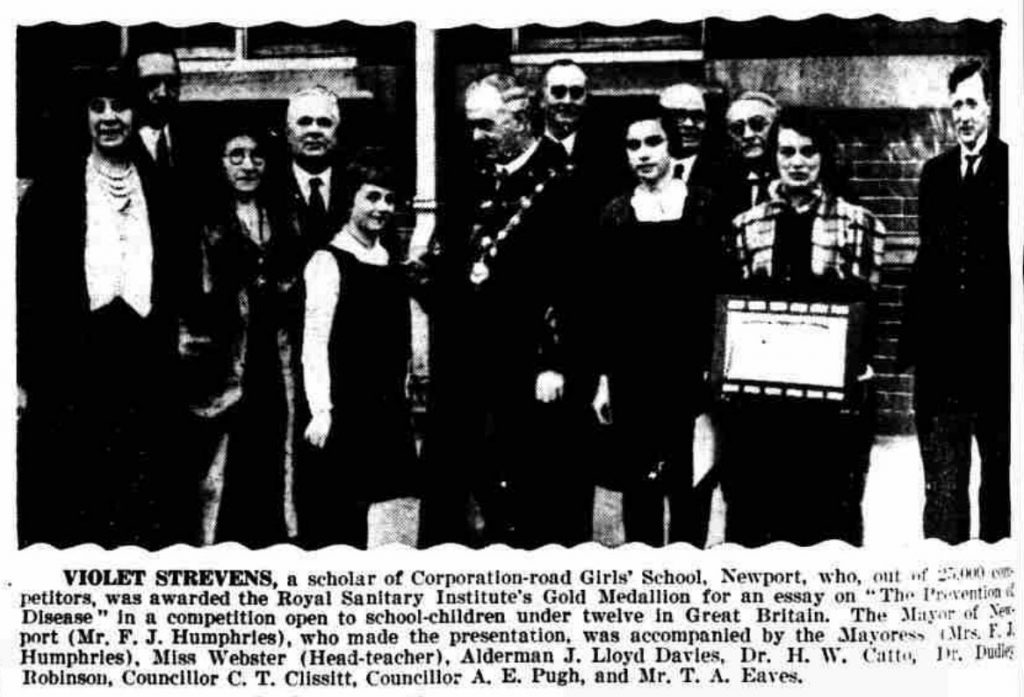
1916 – Former teacher and Chesterfield activist, Rose Ellis marries Alfred Smith of Sheffield.
January 1919 – Rose Ellis Smith gives birth to twins Percy and Edgar in Chesterfield.
June 1919 – Cardiff and Newport Race Riots. Violence breaks out against migrant workers in the dockyards. The protests are reported to have been stoked by the various Seamen’s Unions . The finger was pointed at Bolshevism and demobilisation. Large volumes of ex-servicemen and local troublemakers clash with soldiers.
December 26th 1919 – Percy Toplis and Cardiff’s Morgan Radford Gardiner are alleged to have stolen a £900.00 Sunbeam car belonging to War Secretary, Winston Churchill from Bulford Camp. Gardiner was the grandson of Wesleyan Minister, Ebenezer Adlington Gardiner, a minister who had served at Bolton, Cockermouth, Falmouth and Nottingham (Confederate of Toplis, Globe 04 May 1920, p.1).
1920 – Sanforth Street revolutionary Rose Ellis Smith moves to Mansfield. Here she joins John Lavin and Owen Ford at the Socialist Labour Party.
May 1920 – A national manhunt is underway to capture Percy Toplis, wanted for the murder of taxi-driver Sidney Spicer in Andover. In a letter to the Chief Constable of Hampshire Police, the detective leading the hunt, James Lock Cox, is aware that Toplis tramped around Newport and Monmouthshire in his youth but there is no mention of his aunt Ruth, despite several witness reports placing Toplis in the town. Merthyr Tydfil man, George Bale (19) claims he was handed a Webley revolver by Toplis at Newport Railway Station in the first week of May 1920 (Remarkable Incident at Newport Station, Western Gazette 07 May 1920, p.12). Was this a deliberate ploy coordinated by a local support network to convince the Police and press that Toplis wasn’t armed?
May 1920 – Newspaper report that Police have cordoned off large areas of Monmouthshire, South Wales in response to sightings of Toplis at Pontypool, Pontnewynydd and Cwmffwddoer. He is also reported to have visited Salem Baptist Chapel at Blaina. The chapel, just a mile from Mutineer Jesse Short’s birthplace in Nantyglo, would have served Short’s own baptist family. It was later used as the rallying point for the Blaina Riots (Toplis at Prayer Meeting, Dundee Evening Telegraph 13 May 1920, p.3).
May 1920 – In a hand-written formal statement, Toplis accomplice and key witness Harry Fallows tells Police that Toplis visited several individuals at Dynevor Place and De-La Beche Street in Swansea. Fallows claims that it was here that Toplis tried to sell Spicer’s taxi-cab. Russian criminal ‘fence’ Jack Kramsky’s house was on Prince of Wales Road little more than two minutes away. The press reports of the period suggest that Percy visited a man called ‘Jack’ at one of the houses he visited (Western Gazette 28 May 1920). At this time Mary and Thomas Toplis, who were found guilty of harbouring the Kramsky family, were living at Old Castle Road, Llanelli, not far from where a hoard of cash was found stashed in the ground.
By the 1920s, Jack Kramsky had became a successful scrap metal dealer and small colliery owner (Old Castle Colliery and Wenallt Colliery). The family later became associated with the HeHalutz movement.
June 6th 1920 – After a shoot-out in Tomintoul in the Scottish Highlands Toplis escapes first to Aberdeen, then to Carlisle. He is ambushed and shot dead by Police in Plumpton, near Penrith. A hasty inquest follows. Toplis is buried in an unmarked grave in Penrith’s Beacon Hill Cemetery.
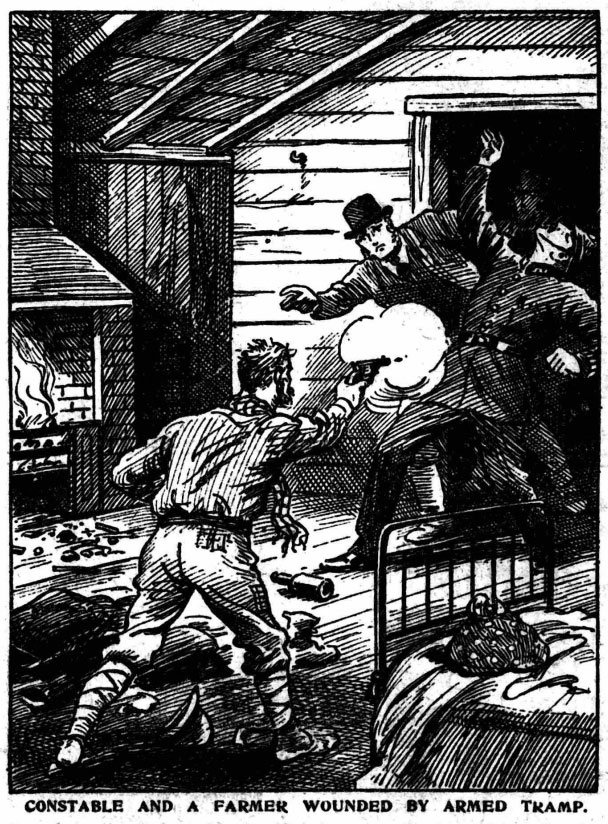
1922 – Rose Ellis Smith and Mansfield’s Socialist Labour Party merge with the recently formed Communist Party of Great Britain.
1926 – Ruth Webster becomes Headmistress at Corporation Road Girls School in Newport. One of Ruth’s principal teachers was Miss Gwyneth Owen, daughter of Baptist Minister, Owen Marianydd Owen. The school may have been affiliated to the W.R. Lysaght Institute on Corporation Road.
June 21st 1926 – Rose Ellis Smith works becomes a prominent member of the National Minority Movement led by Tom Mann and Harry Pollitt. Speeches in Mansfield made with Miners Federation leader, A.J Cook are closely monitored by Mi5. Police arrest Smith (Mansfield Disorders, Woman Arrested, Nottingham Evening Post 22 June 1926, p.1)
1936 – Ruth Webster retires as headmistress of Corporation Road Girls School and moves to West Kensington, in London.
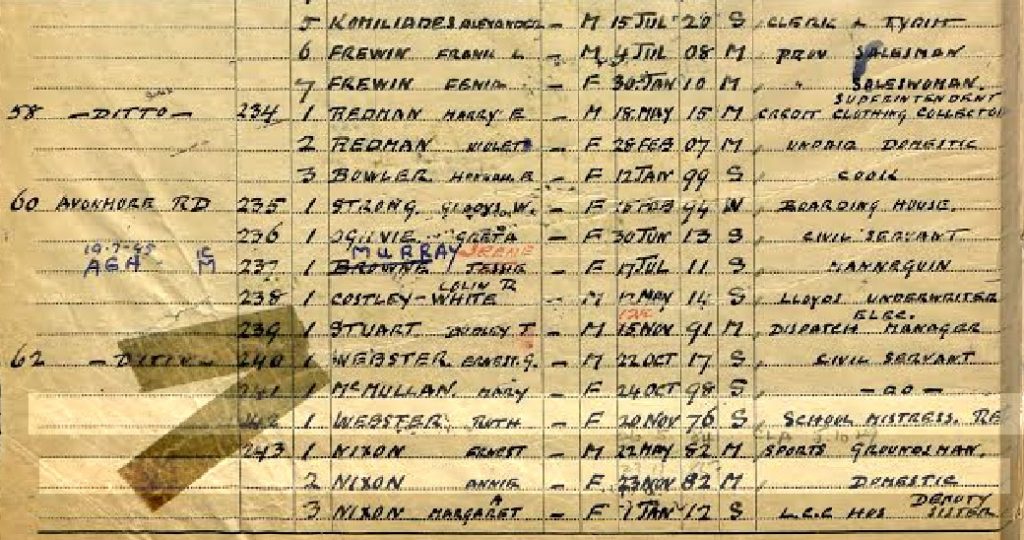
April 1939 – In the 1939 Census, Ruth is seen living with her sister, Annie Nixon and her husband Ernest. The address is 62 Avonmore Road, West Kensington. They are sharing the house with what appears to be Annie and Ernest’s daughter Margaret Nixon (b. January 1912). The son of Ruth and Annie’s cousin, Ernest G. Webster (b. Oct 1917), a civil servant, and Mary McMullan (b. October 1898) also reside at the address. Ernest served as a civil servant in Her Majesty’s Custom & Excise Department. Ernest’s father, also called Ernest, was born in Skegby in 1880. Like Rose he taught locally until securing a more permanent position in Birkenhead, Liverpool. His wife was Chesterfield-born , Edith Annie Fryer, also a teacher. After several appointments in Wigan, Pemberton and Ilkeston, Ernest Snr. was made Headmaster at Manor Road Council Senior Boys School in Wallasey in 1928.
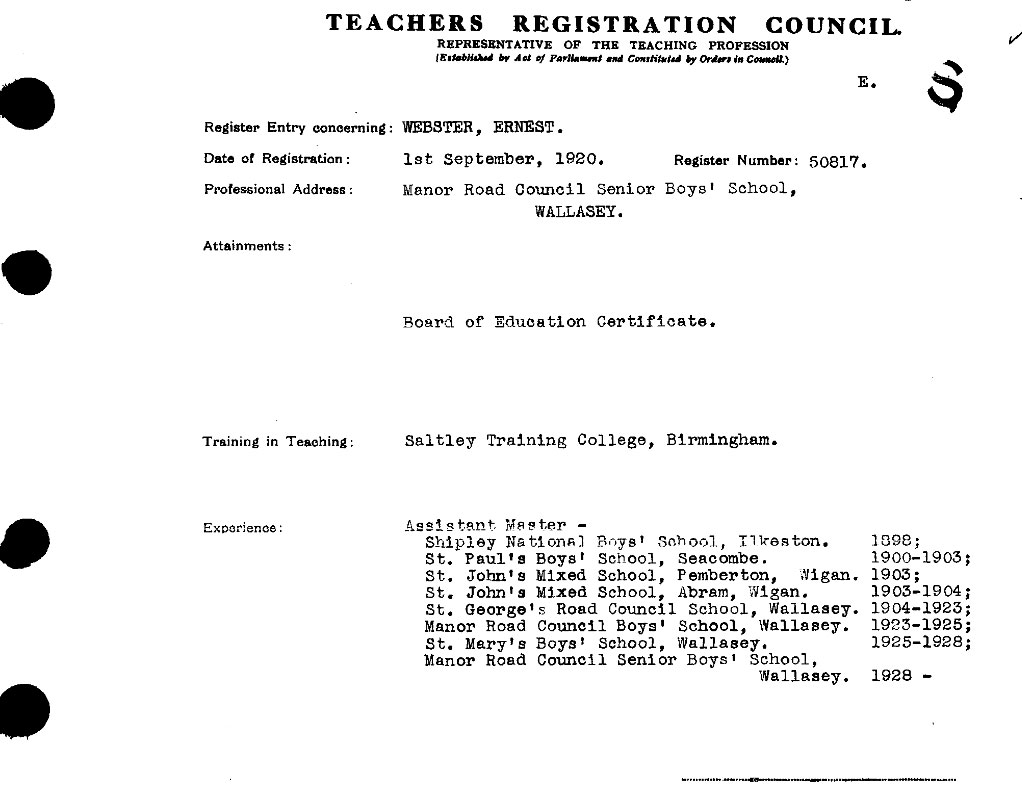
Sadly I have not been able to locate either Margaret Nixon or Mary McMullan in the England and Wales births index. It may be that they were born in Ireland, Scotland or abroad. 4
1946 – Ruth Webster dies in West Kensington, London.
Notes
1 The boy whose memory Fairley and Allison rely on here is Charlie Frederick Foulkes of South Street South Normanton, who was born some four years after Percy. Even so, Foulkes did have it right about headmaster John Bailey, as Bailey did appear to have submitted a petition to the Entertainments Committee at Downing Street, South Normanton around 1911 (serving a complaint about the mass removal of boys to another school). As Percy and his parents were living at Hill View in Westhouses, Blackwell in 1911, it’s difficult to understand why Percy would be in South Normanton.
2 Sarah Ann Gardiner’s family were Methodists from the Bristol and Cardiff area. Curiously it was another Methodist, Morgan Radford Gardiner who is alleged to have stolen Churchill’s car with Toplis in December 1919.
3 The family of Charles de Courcy Parry, who led the ambush on Toplis on the instructions of the British Home Office in May 1920, were prominent mine owners around Newport and Merthyr Tydfil. Parry had at one time been Chief Superintendent of the Glamorganshire Police dispatched to quell the riots. Parry’s father-in-law, Major GW Wilkinson, was a major stakeholder at Risca Collieries near Aberdare. It’s entirely possible that Mutineer Jesse Short and his family had worked at Risca
4 Writer and spy, Compton Mackenzie who had co-founded the Scottish Nationalist Party with Hugh Macdiarmid had lived at 54 Avonmore Road. Mackenzie had served with British Intelligence in the Balkans during the First World War. In 1932, he was prosecuted the following year at the Old Bailey under the Official Secrets Act for quoting from supposedly secret documents.
